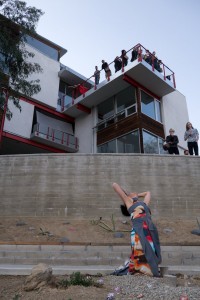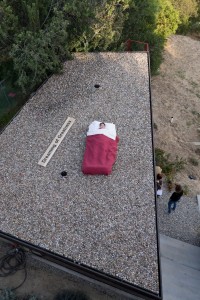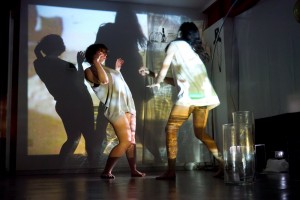As a lover of dance and a lover of architecture, I was both excited and fearful about “HomeLA,” the dance performance held on May 4th in a private home on the cliffside heights of Mount Washington. Directed by Rebecca Bruno, working in partnership with the Dance Resource Center and the dance lab Pietor, the recent site-specific event advertised 14 choreographers on the bill, some with companies, some working solo. As the day approached, I began envisioning the crowding that seemed inevitable when you consider the liberation of so many choreographic visions and bodies inside a family residence. Surely the audience would be wedged into corners, shuffling for space, while a treacly layer of hyper-flexible human forms oozed through the rooms. The foreshortened perspective would grossly limit any choreographic structure and the temptation to interact with the environs would drive heretofore-contained artists to mount furniture and hug walls. Really, there was so much to dread.
How wrong I was. Reaching the aerie concert space by foot (ticket holders were asked to park further down the hill), the road unfurled one amazing retro-eco-futurist structure after another, with the performance site near the very end of the lane, in the magnificent modern home of Chloë Flores and Tim Lefevre. Designed by Fung & Blatt and built by Lefevre himself, the 3800-square-foot compound sat on four major steppes on the hillside, a nifty puzzle of modestly scaled rooms threaded with bridges, balconies, terraces, staircases, landings, and footpaths. Myriad plunging south-facing views were revealed: the distant Oz-like city view was dominated by the historic 1885 Los Angeles County Hospital complex; within close range, there was a hardly another structure visible, just rolling scrub hillsides pitching this way and that. Tethered by exposed orange-hued horizontal beams, and directly touching the earth in only a few spots, the floating home felt primed to surf the evening breeze as temperatures cooled after sunset. “People scatter through this house like water through a colander,” LeFevre explained.
No matter the size and orientation of this beautiful place, icky choreography would have still felt ruinous. Bruno’s assignment to these artists (“to activate the unique architecture and particular ethos of a home”) inspired all manner of environmental rapport from the slew of great solo artists, including hillside diggings and scrambles (Maya Gingery’s “In the Place Where Man and Nature Meet…,” Amanda Furches’ “The Mountain”) to sunset/moonrise rituals (Ronit Kirchman’s “Liminal: Night,” Flora Weigmann’s “Swimming Laps”) to silent performance-art installations (Melanie Rios’ “Dreaming of Greatness”). The clarity of solo performance fit beautifully in these environs, because although the house unfurled a treasury of indoor and outdoor ‘rooms,’ the essence of its design was derived from subtraction and separation, from isolating certain areas by interrupting flow and drawing boundaries. In this spirit, possibly the most inspired intellectual response to the home’s negative space was “Floor Plans” by Meg Wolfe and Kate Gilbert, which took place on a hidden balcony, accessible only by ascending a step stool and peering through a high window. While Wolfe sat out of view, shredding years worth of choreographic notes into tiny pieces and reassembling them into new collages, Gilbert worked with long lines of yellow string, casting and looping it, alternating taut clean lines with sudden tangles and puddles.
With free drinks, clear skies and the freedom to range between numerous vantage points to watch a performance, the event turned party-like easily and quickly. And in acknowledgement of those who might be questioning how to ‘look’ at dance, Nick Duran’s “Peripheral Son” offered a highly meta lesson. Along the lower viewing paths in the backyard, where I encountered them, his dancers were approaching people with the question: “Would you like a performance?” in a casual, friendly manner. They’d then instruct the person to hold still and gaze fixedly in the distance, at which point the dancer would begin moving beside their ‘audience,’ delivering a mysterious combination of shifting air currents and breathy noises, which would in turn deliver a third dance to any onlookers watching this pair together.
Sadly, the revelry inspired by the event cause a good number of folks to spin out from the place in search of greater heights before “ZZA Sduai Airbara” began. Housed in “The Bunker Shelter,” a subterranean room with its main windows facing out into the darkened hollow beneath the living room, the mesmerizing piece — comprised of lights, moving vases, and moving bodies — captured all the potentiality and frisson of looking into someone else’s lighted windows when darkness falls. There was amazing dual shadowplay of bodies and objects — morphing and swelling and receding — cast both inside the room and out onto a nearby exterior wall.
I now know how to find satisfaction on a Saturday night. I want to do HomeLA every weekend. The series is supposed to continue. You should be there.


